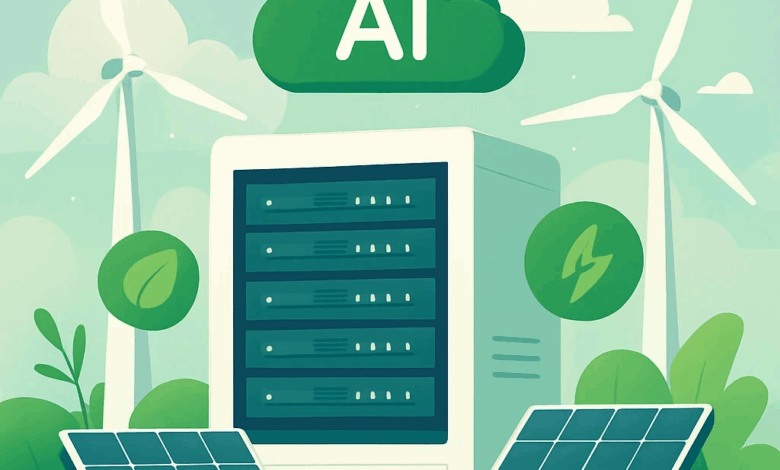
Artificial Intelligence (AI) is hailed as the innovation of the 21st century, however its role in sustainability is complex. While AI has proven extremely useful in very mission critical use cases, for instance Google’s new AI model to forecast tropical cyclones, its own development, deployment and maintenance of the cloud infrastructure and data centers comes with a substantial carbon footprint. The challenge for us is to ensure that the environmental benefits of AI outweigh its costs, making it a net positive impact for the planet and the generations to come.
The Carbon Cost of AI
According to industry reports and research studies, training Large Language Models (LLMs), for instance GPTs, is energy-intensive. For example, training a single large transformer-based model can emit over 284 tons of CO₂. This corresponds to 5x the lifetime emissions of an average car and 50x of the annual emissions of an average person. Training a BERT-base model consumes as much energy as a trans-American flight, while models like GPT-3 and GPT-4 have training runs that emit between 300 and 552 tons of CO₂, equivalent to over a hundred round-trip flights between New York and Beijing.
In 2022, data centers and cloud infrastructure consumed about 460 terawatt-hours (TWh) of electricity globally. This is expected to double by 2026, the reason- rapid digitization and huge AI demand. Furthermore, these centers also require significant water for cooling, and their environmental impact depends on whether their electricity comes from fossil fuels or renewables. As of now, AI contributes to 0.01% of global greenhouse gas emission, however with the rapid growth of the field means that this percentage could rise multifold.
AI’s Potential for Sustainability
AI is pretty good at optimizing almost everything. Hence, AI can be one of the greatest tools for all the sustainability problems. AI can help optimize systems that can reduce wastes, can help enable smarter resource management, can help predict natural disasters hours before it actually happens.
Smarter Supply Chains
AI can streamline global supply chains, reducing inefficiencies that lead to wasted energy and excess emissions. Machine learning models can analyze data from shipping, manufacturing, and demand forecasts to optimize inventory, logistics, and routes. For instance, AI can help route optimization algorithms minimize fuel use by collecting real-time traffic data and predicting based on historical trends. The idea is that AI does not magically reduce carbon emission, however it provides with powerful tools that can be used to significantly reduce carbon emissions.
Greener Data Centers and Smart Energy Management
Data centers are major energy consumers, especially for AI workloads. There are billions of dollars being spent in research to enhance the efficiency in data center related to both performance and sustainability. Infact, BigTechs often use AI to optimize this. For instance, AI can dynamically adjust cooling, schedule computing jobs when renewable energy is abundant, and shift workloads to cooler regions, further reducing emissions
On the consumer side, AI-powered smart thermostats and building management systems can optimize heating, cooling, and lighting, cutting energy use without sacrificing comfort. Trials have shown notable reductions in electricity use and emissions simply by running buildings more intelligently.
Optimizing Resource Use Across Industries
AI can analyze complex systems and make real-time adjustments at pace that humans cannot match. For example, in manufacturing, AI optimizes processes to reduce material waste, energy consumption, and defect rates, with studies showing 30–50% cuts in waste and carbon output compared to traditional methods. In agriculture, AI-enhanced tools help apply water, fertilizers, and pesticides only where needed. This potentially lowers environmental impact and improves crop health through early detection of stress or pests. Transportation systems benefit from AI-driven route optimization, improving fuel efficiency in airlines and logistics while reducing emissions through smarter public transit scheduling and traffic signal coordination. In resource extraction and recycling, AI enhances mining precision to avoid unnecessary excavation and powers intelligent sorting robots that improve the purity of recyclable materials, promoting a more sustainable circular economy.
Looking Forward
AI is not a climate solution, but is a very powerful tool. When developed and deployed with the right intention, it can significantly amplify efforts to address environmental challenges. Even after considering its own energy use, research shows that AI’s overall contribution can be net-positive “if” we use AI strategically. From reducing emissions and waste to optimizing renewable energy and supply chains, AI is already making meaningful contributions across industries.
But achieving its full potential requires responsible design. This means building energy-efficient models, operating on green infrastructure, and ensuring transparency around emissions and performance. It also means strong governance and a commitment to solving real problems, not just creating flashy tools with minimal substance.
If we align AI innovation with sustainability goals, the result can be transformative. Rather than replacing human action, AI is a powerful catalyst for a more efficient future.





